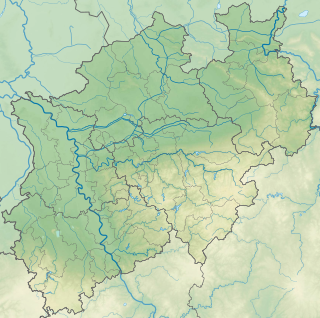Bever-Neye-Kerspe-hinterland
| Bever-Neye-Kerspe-hinterland | |||
|---|---|---|---|
| Aerial view of the Bevertalsperre in the back country | |||
| Systematics according to | Handbook of the natural spatial structure of Germany | ||
| Greater region 1st order | Low mountain range threshold | ||
| Greater region 2nd order | Rhenish Slate Mountains | ||
| Main unit group | 33 → Süderbergland |
||
| About main unit | 338 → Bergische plateaus |
||
| 4th order region (main unit) |
338.1 → Bergisch-Märkische plateaus |
||
| 5th order region | 338.13 → Wupper-Ennepe plateaus |
||
| Natural space |
338.131 → Bever-Neye-Kerspe-hinterland |
||
| Geographical location | |||
| Coordinates | 51 ° 8 '23 " N , 7 ° 24' 5" E | ||
|
|||
| local community | Wipperfürth , Hückeswagen , Halver , Kierspe | ||
| state | North Rhine-Westphalia | ||
| Country | Germany | ||
The Bever-Neye-Kerspe ridge land is a natural spatial unit with the number 338.131 and, according to the handbook of the natural spatial structure of Germany, comprises the mountain ranges between the Wippermulde (ordinal number 338.12) in the west and the watershed between the river systems of the Wupper and the Ennepe (and thus ultimately the Ruhr ) in the east. In the north, the back country borders on the Neuhückeswagen , Eckenhausen , Niederdahlhausen , Hönde , Altendorf and Schwenke line on the Radevormwald plateau (ordinal number 338.130) with which it forms the Wupper-Ennepe plateau (ordinal number 338.13). The Wipperquell area (order number 338.3) connects to the south . The area includes the southern edge of the Radevormwald urban area, the southeast of Hückeswagen , the parts of Wipperfürth east of the Wupper, the western edge of Halver and the northwestern tip of Kierspe .
The ridge slopes from the Wupper / Ennepe watershed in the east to the Wupper in the west and consists of 370 m high rump areas with moderately sloping, approx. 50 to 70 m deep valleys of the Bever , Neye , Hönnige and Kerspe between them. Due to the high annual rainfall , the effect of the Wupper / Ennepe watershed as a rain catcher and the favorable valley structure of the area, the back land was very suitable for the construction of drinking water and process water dams, so that in the early 20th century the Bevertalsperre , the Neyetalsperre , the Schevelinger dam and the Kerspe dam were built.
The rock strata in the west belong mainly to the Lower Honsel strata consisting of slate and sandstone , while in the eastern Hönnige and Kerspeg area Lower Devonian Remscheider , Rimmert and Ebbe strata predominate. With a height of almost 400 m, the backbone of the Riedelland is the Wupper / Ennepe watershed, which runs from north-west to south-east, behind which the Halver-Lüdenscheider plateaus (order number 336 1 .6) connect to the east . Cross ridges drop from the jagged ridge into the valleys of Bever, Neye, Hönnige and Kerspe.
The back country has an agrarian settlement structure with numerous individual farms that mainly operate grassland . The steeper slopes are often forested.

